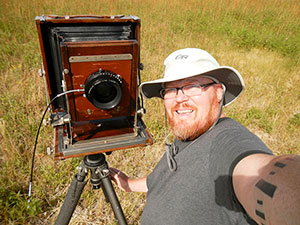 *
*
I recently caught up with Somerville photographer Bruce Myren to conduct an interview about his life and his accomplished work.
From his website:
Bruce earned a Bachelor of Fine Arts in photography from the Massachusetts College of Art and Design and a Master of Fine Arts in studio art from the University of Connecticut, Storrs.

Somerville photographer Bruce Myren
Myren’s photographs have been featured in various publications such as the Boston Globe, Boston Phoenix, Boston Magazine, Fraction Magazine, Afterimage, and View Camera Magazine. His photographs are part of collections owned by Fidelity Investments, the Center for Creative Photography, the Library of Congress, and many private individuals.
His project, The Fortieth Parallel, has been included in critical/art historical essays by Katherine Palmers Albers and Kelly Dennis. He has also been showcased in numerous group exhibitions across the United States and displayed in distinguished art galleries such as the Phoenix Art Museum, RISD Museum’s Chace Center, Houston Center of Photography, the William Benton Museum of Art, and Gallery Kayafas, where he is represented.
Aside from his artistic work, Myren is employed at the Boston Public Library’s Digitization Lab, is the photographer at the Peabody Museum of Archeology & Ethnography at Harvard University, and owns Bee Digital Lab. He has taught photography at Fitchburg State University, Amherst College, Rhode Island School of Design, Art & Design at Lesley University, the University of Massachusetts, Dartmouth, and Northeastern University.
Myren is an active member of the artistic community, and he has received recognition for his work through a Cambridge Arts Council Grant; he is an alum of Review Santa Fe and served as a juror for the Griffin Museum of Photography and The Rhode Island State Council of the Arts. He has presented on panels at the College Art Association and the Society for Photographic Education national conferences. He was the Northeast Chapter of SPE Chair from 2010-2016.
Doug Holder: First off, how has it been for you as a creative working in Somerville at the Vernon Street Studios?
Bruce Myren: I enjoy being a part of the community here at Vernon Street Studios. Everyone is friendly and cares about each other. Additionally, we have the opportunity to open our studios twice a year. The Vernon Street Studios is celebrating its 50th anniversary this year. The public should be looking for news about the celebration this coming fall. The fact that the studio is just a mile from my home and now has the Green Line just a block away makes it even better. However, there is also the concern of gentrification and increasing rent prices that could potentially force artists out of the building. The availability of affordable artist spaces is a significant issue in the Greater Boston area. It would be helpful if the city could provide more support for artists, such as a rent stipend or voucher system to help offset the costs of maintaining a studio in Somerville. Additionally, it is essential to consider that not all artists’ work directly engages with public and social issues, so funding should not be limited to those aspects of artistic output as it could exclude a lot of artists.
DH: Your day job is at the Boston Public Library with the Lab and Palm Press, a digital project. Can you tell us about this?
BM: I work multiple jobs to support my art, as many artists need to. One of my roles is as a digital imaging specialist at the Boston Public Library. In this job, my responsibilities include digitizing old film negatives from the BPL’s collection and other non-profit organizations in the Commonwealth. I get to view many fascinating old pictures of the local landscape, which helps me fuel my creative practice.
Apart from that, I also own a consulting, printing, and scanning business for other artists called Bee Digital Lab. We offer photography and personalized service, often working one-on-one at the studio, making prints the way the client wants.
DH: You stated in your bio that you investigate issues of space and time in your photography. How does this play out?
BM: Photography is a medium that captures a unique moment in time and space, transforming it into a permanent 2D image. As a photographer, I create new spaces and connections within this structure by selecting my subjects carefully. My work examines history as a living entity, which is projected into the future by displaying the photographs.
DH: In your latest photo project titled Return of Elms, you make a study of Elm trees. I have seen the stately Dutch Elms in Boston and I always viewed them as a patrician tree. What draws you to these trees, and how does it fit in with your study of time and space?
BM: My projects are about how art can connect the past, present, and future. The Return of Elms photography series incorporates black and white film to pay homage to the past but also features images of contemporary trees in urban environments to look towards the future. The series captures the daily life surrounding these trees, showcasing how they are an essential part of our world.
DH: Why should we view your work?
BM: I think that looking at art can be a great way to connect with different perspectives, cultures, and ideas. I want to think that my art evokes emotions, sparks conversations, and inspires others’ creativity. Art can also provide a way to better understand the world around us, whether through historical context or contemporary issues. Additionally, viewing art can be a form of self-care and relaxation, allowing us to take a break from our busy lives and immerse ourselves in something beautiful or thought-provoking.

















Reader Comments